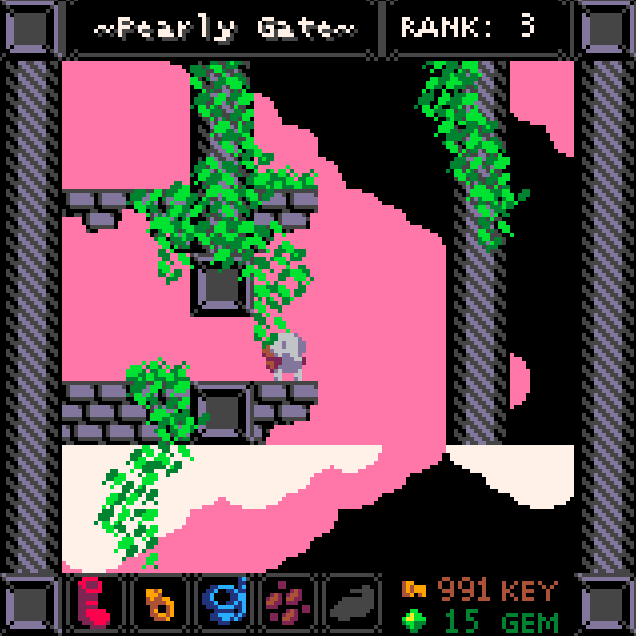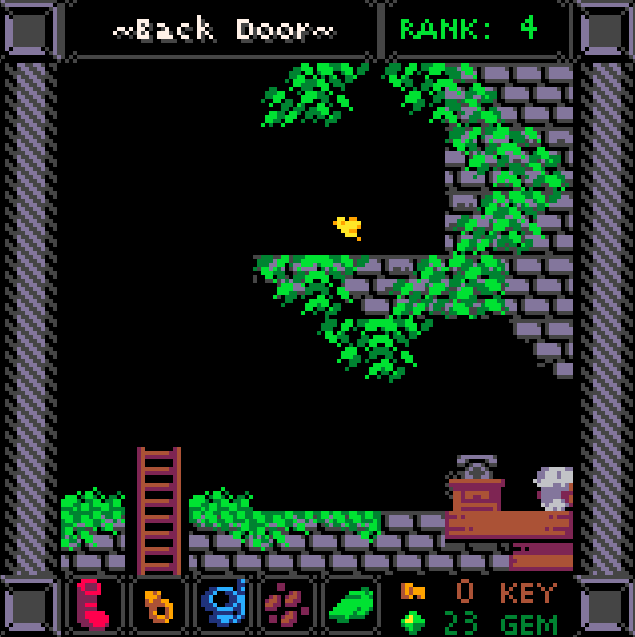By Linker (cohost / Twitter / itch.io)
In 2020 I released a small game called Elephantasy. In it, you play as a little elephant (named Belle) who gets stuck in a miniature world and has to find her way back home. It’s a puzzle platformer with grid-based movement and an item-borrowing system much like in Zelda: A Link Between Worlds; you borrow items from a central hub, and as you collect gems in the world, you get more item slots. Initially, you can only carry one of four items at a time, but as you progress, you can carry more at once. Thus, Elephantasy’s gameplay mostly involves exploring, and figuring out how to get between areas using specific combinations of items.
Now, Let’s Talk About Softlocks
One of the issues with grid-based movement and non-linear exploration of Elephantasy is that there are lots of situations where the player could, potentially, get soft-locked. For those not well versed in video-game jargon, a soft-lock is a situation where a player, either through their own actions or the actions of a developer, cannot progress in a game, but where the game itself is still playable.
Falling into a pit and not having the appropriate items to get out, for instance, would be a soft-lock; it’s also more common than one might think in Elephantasy, and I used a number of tricks to avoid this being an issue. Player-placed props, such as pots or lanterns, will despawn after some time has passed, meaning that if a player is stuck because of their own actions, it’s never permanent. And, to aid in this, rooms were built specifically to avoid situations where players could get stuck. So, given this fear of soft-locks, it may come as a surprise that the biggest tool for avoiding them in the final game (a teleport directly back to the hub area from anywhere) wasn’t initially something that I added for that purpose.
The Item Swapping Problem
I initially added a warp function into the game as a fifth, passive item; once you complete a small side-quest in the mid game, you get a whistle that lets you teleport freely between areas, whether you’ve discovered them or not. Because this was an optional item, I built the game world without the ability to warp in mind. But after initial playtests of the final game, I found that there was a common complaint among players: switching items at the hub was too tedious and annoying!
In pre-release versions of Elephantasy, players would have to run back to the hub themselves whenever they wanted to switch between held items. As mentioned earlier, this is a big part of the gameplay; you can go pretty much anywhere you want, but you’re limited by how many items you can carry at once, and what combos you bring into a given area. So if that core gameplay loop was tedious, it was a big problem!
I had added the warp whistle in an attempt to nip this issue in the bud, hoping that players would tolerate exploring and hoofing it back to the hub until they eventually found the whistle. This was short-sighted on my part. Backtracking to explore or find something new in a game can be fun, but backtracking because you’ve made a mistake is quite the opposite. On top of that, not many playtesters actually found the whistle in the first place. In hindsight, the whole situation was a necessary lesson in the value of playtesting. What I was willing to tolerate from my own game, as a developer, was very different from what my players would tolerate, even if they enjoyed the rest of the game. Their expectations and experiences were not the same as mine, and I could not fundamentally control how they played my game, or how they would react to my design decisions.
Regardless, I now had a conundrum on my hands: how could I remove the tedium of backtracking to the hub, and not undermine the warp item I’d already added? I didn’t want to redesign the world (I was already late in development), and the item swapping system was pretty integral to the overall gameplay, so I couldn’t scrap that.
Two Birds, One Warp
The solution I eventually settled on was to tweak the original warp system. In the final game, you always have the ability to teleport to the hub from any solid ground. This was effectively just the warp whistle I’d already implemented, but with only one warp available. Then, if you get the whistle item, you gain additional warps to other areas. That way, players who were stuck in an area without the correct item(s) could always immediately go back to the hub, take a different item, and head back to where they were. In short, it effectively removed the annoying part of backtracking (at least in one direction). But it also did something else: it solved the soft-lock problem! If players were stuck, no matter how badly, they could always get themselves unstuck by going back to the hub! And, surprisingly, I’d just stumbled onto this solution by trying to fix a completely different problem!
Conclusion
I struggled a lot with what I wanted to write for this essay; there are many aspects of game design that I don’t really discuss much, all of which would be good for this kind of analysis. But, I picked this topic because, despite it being pretty insignificant on its own, it demonstrates how development isn’t something you can just plan out in your head and expect to work. For all the thought and theory that goes into “good” game design, there are also times where you can just come up with a significant mechanic, or a fix for a problem, without even realizing it! And, more importantly, even if you put a lot of thought into your design, you should never assume that your players will think about your game the same way you do! Oh, and one more thing: tip your playtesters!!
Game Design Bounty
I’ve always had a soft spot for isometric video games, as well as dungeon-crawlers. In 2020, I was working on a game that combined both of these things; that game eventually led to Elephantasy’s sequel/spinoff, Elephantasy: Flipside! Still, I think if I had the chance, I would love to make something true 3D in that vein, maybe like TUNIC. Alternatively, I’ve always thought it would be cool to make a puzzle game with pre-rendered backgrounds, either in the vein of MYST or the Boku no Natsuyasumi games. I just like the visuals!
Take the reader survey!





